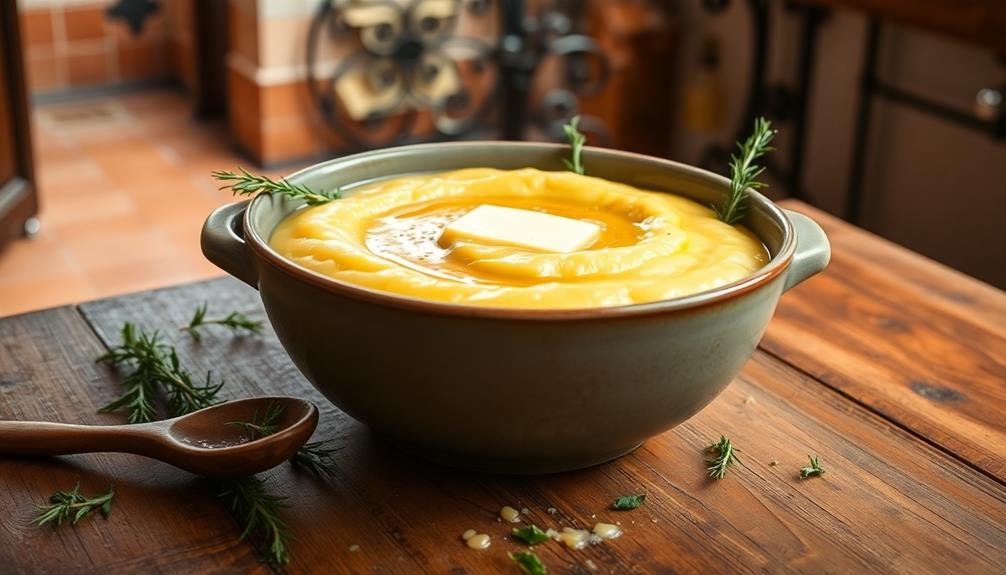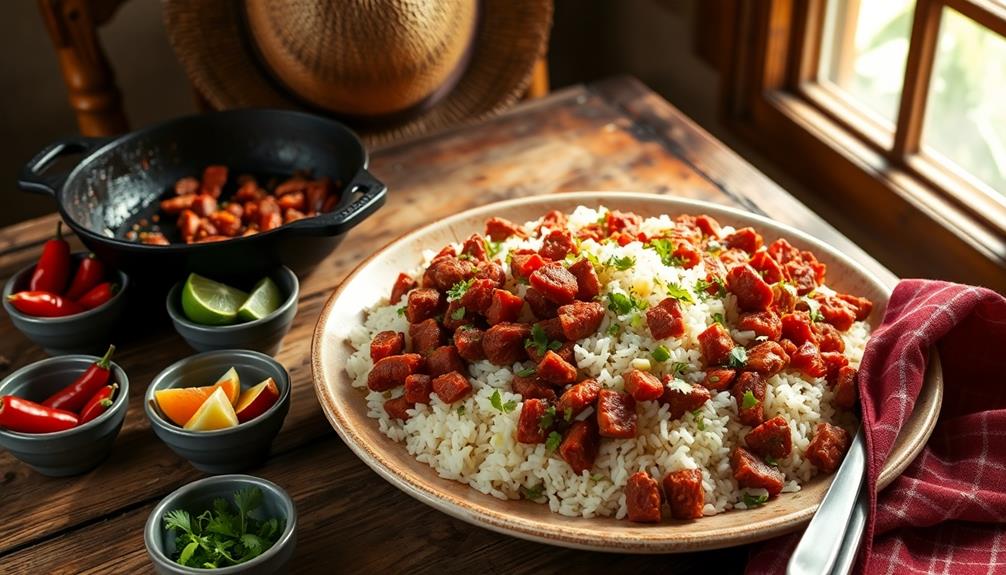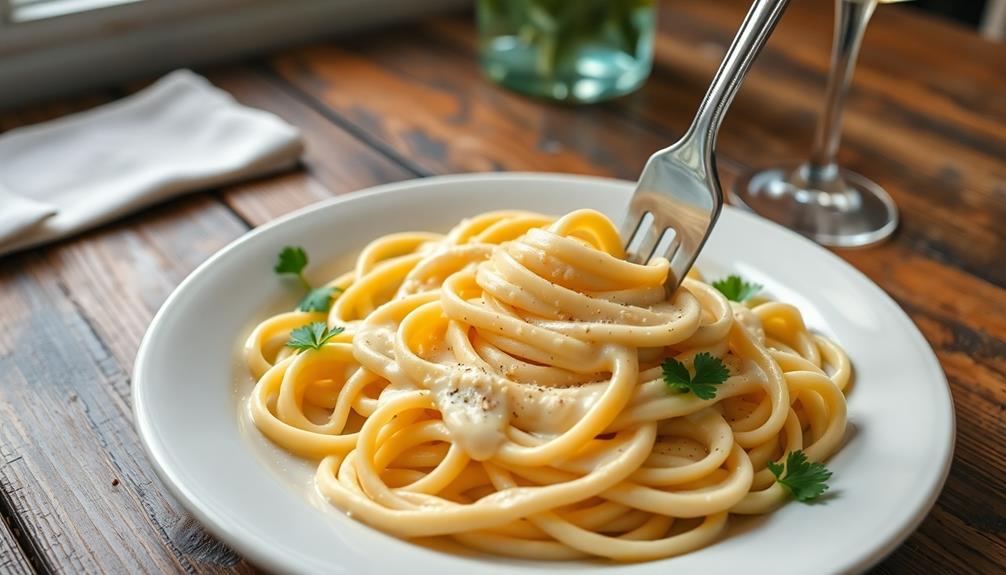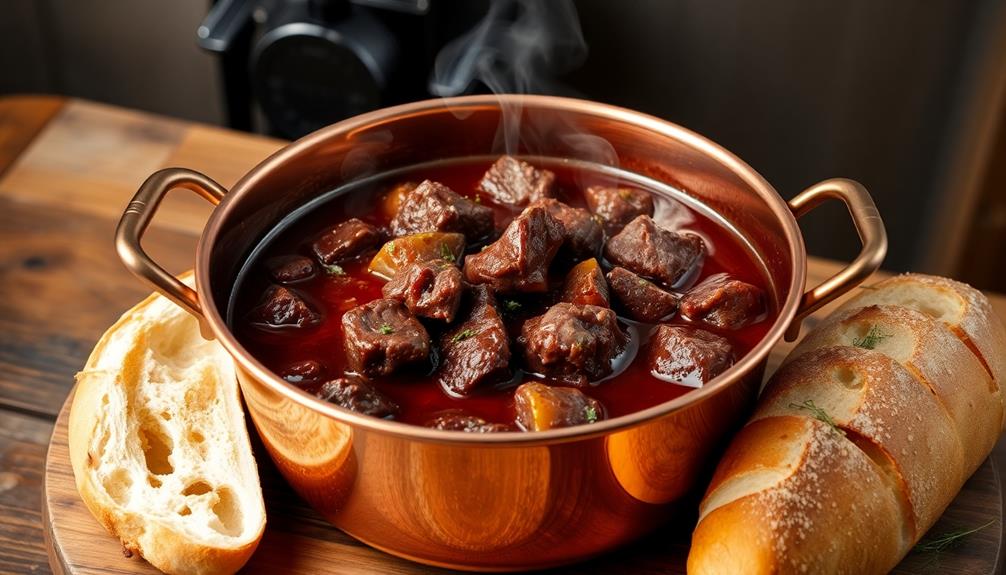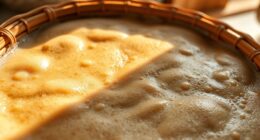Polenta is a delicious and versatile dish you'll love! It's made from cornmeal and has a rich history dating back to Ancient Rome. You can cook it to be soft and creamy or firm and sliceable. It's perfect for family meals and holiday feasts. To make polenta, you'll slowly add cornmeal to boiling water, stirring constantly. Then, you'll simmer it for about 30 minutes, adding butter and cheese at the end. Polenta is great as a base for stews, fried as a crispy treat, or even used as a pizza crust. There's so much more to discover about this tasty and adaptable dish!
Key Takeaways
- Polenta is a creamy dish made from coarsely ground cornmeal, popular in Northern Italian cuisine.
- It can be served soft or firm, depending on preparation, and pairs well with various toppings and sauces.
- Cooking polenta involves gradually adding cornmeal to boiling water and stirring constantly for about 30 minutes.
- Butter and cheese are often added for flavor, and polenta can be shaped, fried, or used as a base for other dishes.
- Polenta is gluten-free, nutrient-rich, and versatile, suitable for both savory and sweet preparations.
History
Throughout history, polenta has been a staple food in many cultures, particularly in Northern Italy. You might be surprised to learn that this tasty dish has been around for thousands of years! Ancient Romans called it "pulmentum" and ate it as a porridge. Over time, it evolved into the polenta we know and love today. Today, polenta is a versatile dish that can be enjoyed in many different ways. It can be served soft, like a creamy porridge, or it can be allowed to set and then grilled or fried. In Northern Italy, it is often paired with hearty stews and sauces, such as the classic Tuscan ribollita recipe. Its simple ingredients and comforting taste have made polenta a beloved dish that has stood the test of time.
In the 16th century, corn made its way to Europe from the Americas. This changed everything for polenta! People started using cornmeal instead of other grains, giving polenta its signature golden color and delicious flavor.
Here are some fun facts about polenta's history:
- It was once considered a peasant food
- Families would gather around a communal polenta board for meals
- Leftover polenta was often sliced and fried for breakfast
You'll find that polenta has played a big role in many festive traditions. During holidays, it's often served with special toppings and sauces.
Isn't it amazing how a simple dish can bring so much joy to people's lives? Next time you eat polenta, remember its rich history and all the families who've enjoyed it before you!
Recipe
Polenta is a versatile and comforting Italian dish made from coarsely ground cornmeal. Its creamy texture and mild flavor make it an excellent base for a variety of toppings and accompaniments, from savory meats and vegetables to sweet fruits and syrups.
This recipe yields a classic, creamy polenta that can be served soft and warm, or cooled and sliced for grilling or frying. The key to achieving the perfect consistency lies in constant stirring and gradually adding liquid, resulting in a smooth and lump-free dish that's sure to please.
- 1 cup coarse cornmeal
- 4 cups water
- 1 teaspoon salt
- 2 tablespoons butter
- 1/4 cup grated Parmesan cheese (optional)
In a large saucepan, bring the water to a boil and add salt. Slowly pour in the cornmeal while whisking constantly to prevent lumps from forming. Reduce heat to low and continue stirring frequently with a wooden spoon for about 30-40 minutes, or until the polenta is thick and pulls away from the sides of the pan.
Remove from heat and stir in butter and Parmesan cheese, if using. Serve immediately for soft polenta, or pour into a greased baking dish and let cool for firm polenta.
For the best results, use a heavy-bottomed pot to prevent scorching and ensure even heat distribution. If the polenta becomes too thick during cooking, add small amounts of hot water or milk to achieve the desired consistency.
Leftover polenta can be refrigerated and reheated with a splash of liquid, or sliced and pan-fried for a crispy exterior and creamy interior.
Cooking Steps
You're about to embark on a fun cooking adventure with polenta!
First, you'll start by boiling water and adding salt, then gradually pour in the cornmeal while stirring constantly.
As it simmers, you'll keep stirring and later add butter and cheese for extra flavor, but remember to let it cool before serving your tasty creation.
Step 1. Boil Water and Add Salt
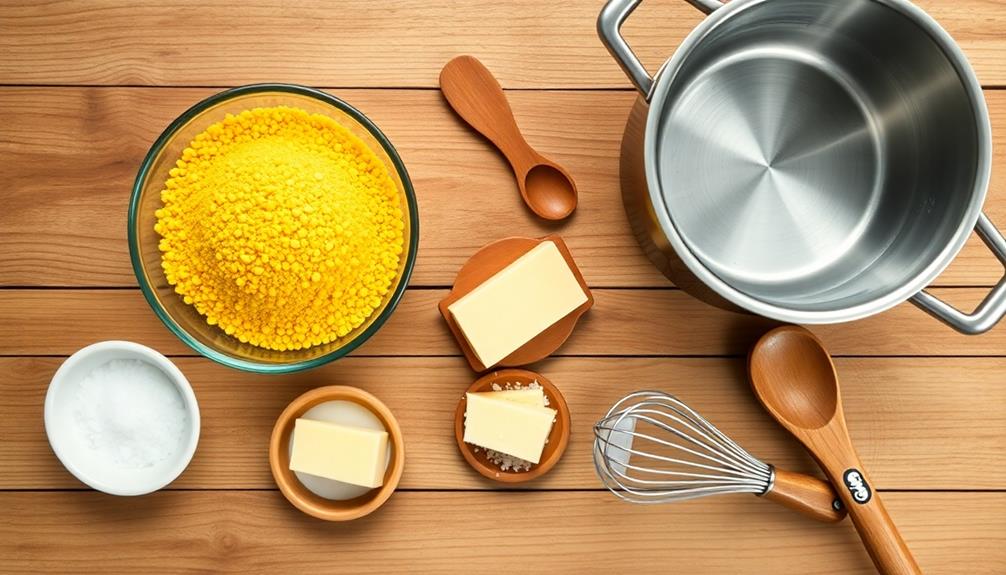
The initial step in preparing polenta is simple yet crucial. You'll want to start by boiling water, which forms the base of your delicious polenta. Here's what you need to do:
- Fill a large pot with water
- Place it on the stove and turn the heat to high
- Wait for the water to come to a rolling boil
Once your water is boiling, it's time to add salt. This step is important because it'll give your polenta a tasty flavor. Remember:
- Use about 1 teaspoon of salt for every 4 cups of water
- Stir the salt in well to make sure it dissolves
You'll notice the water bubbling and steaming – that's perfect! The hot, salty water is now ready for the next steps in making your polenta.
It's exciting to see your dish coming together, isn't it? Soon, you'll be enjoying a warm, comforting bowl of polenta that you've made yourself.
This simple start sets the stage for a delicious meal that your whole family will love. Get ready for the next steps – they're just as easy and fun!
Step 2. Gradually Pour in Cornmeal
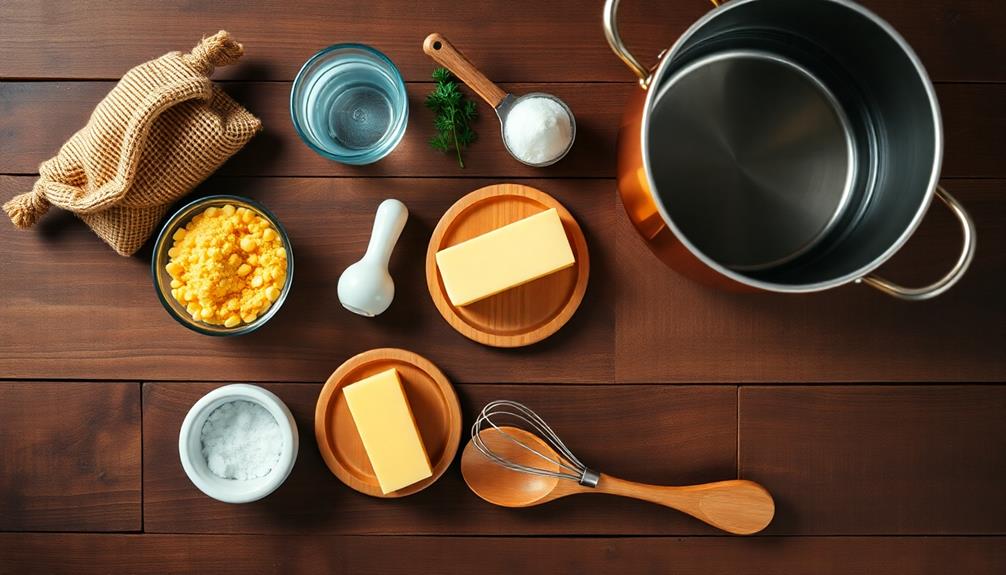
With the water boiling and salted, it's time to add the star ingredient: cornmeal. Get ready for some culinary magic!
Here's how to pour in the cornmeal like a pro:
- Hold the measuring cup with cornmeal in one hand
- Use your other hand to slowly sprinkle it into the pot
- Stir constantly with a wooden spoon as you pour
Remember, slow and steady wins the race! If you dump it all in at once, you'll end up with lumps. Nobody wants lumpy polenta!
As you're pouring, you'll notice the water start to thicken. That's the cornmeal working its magic! Keep stirring and pouring until all the cornmeal is in the pot.
Fun fact: This gradual pouring method is called "rain-in." Imagine you're making it rain cornmeal!
Once all the cornmeal is in, don't stop stirring. You'll want to keep at it for a few more minutes to make sure everything is well mixed.
Your arm might get a little tired, but it's worth it for smooth, creamy polenta!
Step 3. Stir Constantly While Simmering
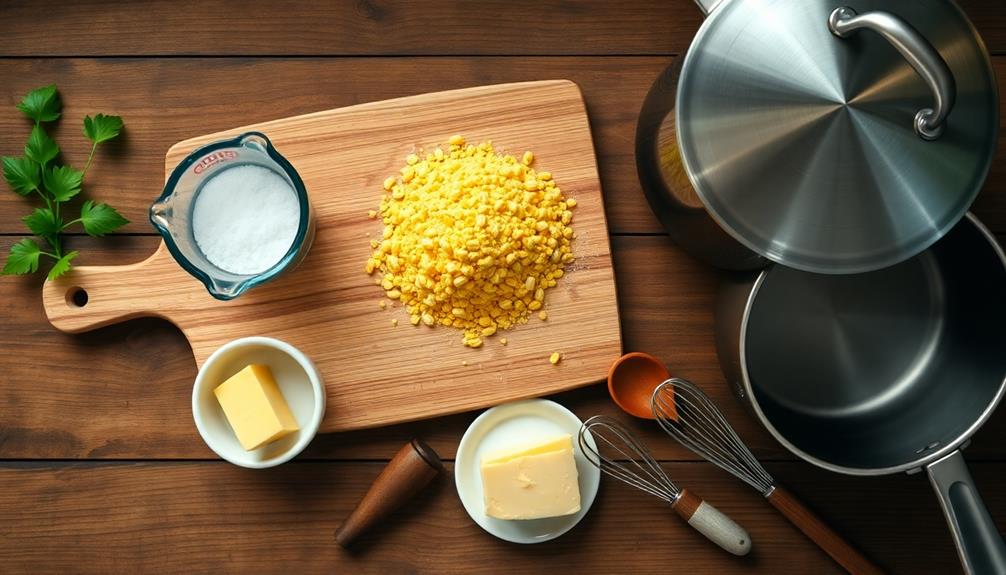
Now comes the crucial part of polenta-making: constant stirring while it simmers. You'll need to keep your wooden spoon moving for about 30 minutes, but don't worry – it's easier than it sounds! As you stir, you'll see the polenta start to thicken and become creamy. It's like magic happening right in your pot!
Here's why stirring is so important:
- It prevents lumps from forming
- It helps distribute heat evenly
- It creates that smooth, velvety texture we all love
While you're stirring, keep an eye on the heat. You want a gentle simmer, not a rolling boil. If it starts bubbling too much, turn the heat down a bit. Remember, patience is key here!
As you stir, you might notice the polenta pulling away from the sides of the pot. That's a good sign! It means you're getting close to perfection.
Keep going until your polenta is thick and creamy, with no raw cornmeal taste. Soon, you'll have a delicious, warm dish that's perfect for any family meal!
Step 4. Add Butter and Cheese
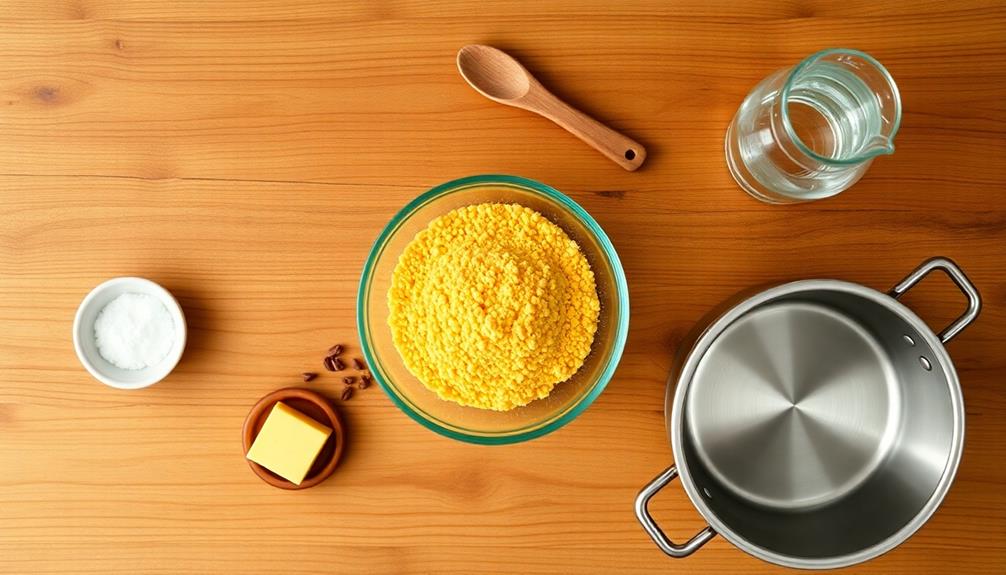
Adding butter and cheese elevates your polenta to new heights of deliciousness.
Once your polenta has finished simmering, it's time to make it extra creamy and flavorful. Here's how you can do it:
- Turn off the heat and remove the pot from the stove.
- Add 2-3 tablespoons of butter to the polenta.
- Stir the butter in until it's completely melted.
Now, it's time for the cheese! You can use:
- Grated Parmesan
- Shredded cheddar
- Crumbled goat cheese
- Or any other cheese you like
Add about 1/2 cup of cheese to your polenta and stir it in well. The warm polenta will help melt the cheese, creating a gooey, delicious mixture.
Don't be afraid to taste and adjust! If you want it cheesier, add more. If it's too thick, you can thin it out with a little warm milk or broth.
Step 5. Let Cool Before Serving
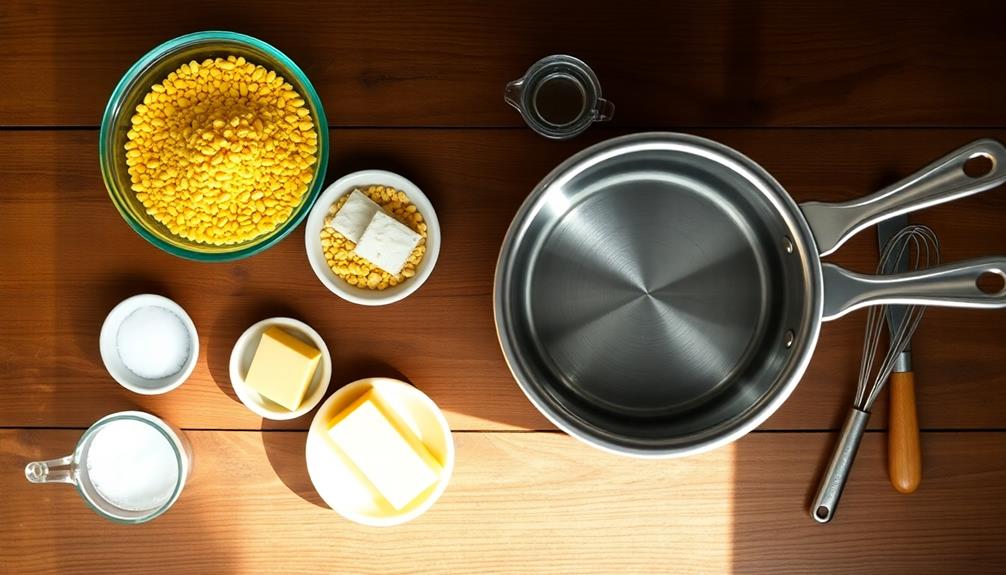
Patience is key when serving polenta. After you've stirred in the butter and cheese, it's time to let your delicious creation cool down a bit. This step is crucial for achieving the perfect texture and taste.
Here's why letting polenta cool is important:
- It thickens as it cools, making it easier to slice or shape
- The flavors have time to meld together
- It's safer to eat when it's not piping hot
While you wait, you can:
- Set the table
- Prepare any side dishes
- Gather your family around
Don't worry, you won't have to wait too long! About 5-10 minutes should do the trick. As the polenta cools, you'll notice it becoming firmer. This is exactly what you want!
Once it's cooled slightly, you're ready to serve. You can:
- Spoon it onto plates for a creamy side dish
- Cut it into squares for a fun, finger-food option
- Shape it into rounds for a fancy presentation
Final Thoughts
As you explore the world of polenta, you'll find it's a versatile and rewarding ingredient to work with. It's not just a side dish; polenta can be the star of your meal!
Here are some fun ways to enjoy it:
- Serve it creamy as a base for stews or sauces
- Cut it into shapes and fry for a crispy treat
- Use it as a pizza crust for a gluten-free option
Don't be afraid to experiment with flavors. You can add cheese, herbs, or even sweet toppings to make it your own.
Polenta is perfect for family gatherings and holiday meals. It's easy to make in large batches and can be prepared ahead of time.
Remember, practice makes perfect. The more you cook with polenta, the better you'll get at achieving the right texture.
It's a great way to introduce kids to cooking, too. They'll love stirring the pot and watching it thicken.
Frequently Asked Questions
Can Polenta Be Reheated, and What's the Best Method?
Yes, you can reheat polenta easily. The best method is to add a splash of liquid (water or milk) and warm it on the stovetop, stirring frequently. You can also microwave it, covered, in short bursts.
Is Polenta Gluten-Free and Suitable for People With Celiac Disease?
Yes, it's gluten-free and safe for those with celiac disease. You'll find it's made from corn, not wheat. Always check labels to ensure no cross-contamination during processing. It's a great alternative to wheat-based starches.
How Long Does Cooked Polenta Last in the Refrigerator?
You can safely store cooked polenta in your fridge for up to 5 days. Make sure you keep it in an airtight container. For best quality, consume it within 3 days. Reheat thoroughly before eating.
Can Polenta Be Used as a Substitute for Other Grains?
You can use polenta as a versatile substitute for many grains. It's great in place of rice, pasta, or couscous in various dishes. You'll find it works well in both savory and sweet recipes.
Are There Any Notable Nutritional Benefits to Eating Polenta?
You'll find some notable nutritional benefits in this dish. It's rich in complex carbohydrates, providing sustained energy. You're also getting a good dose of vitamins and minerals, including iron, zinc, and B vitamins. It's naturally gluten-free, too.
